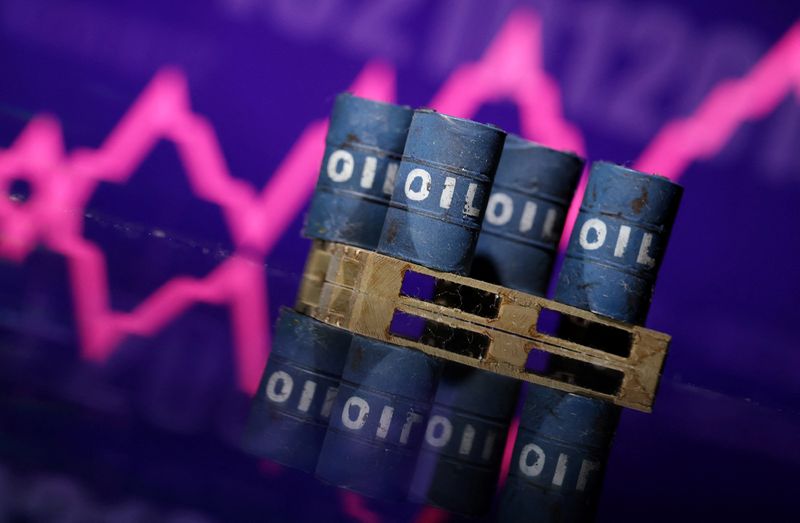By Georgina McCartney
HOUSTON (Reuters) -Israel’s surprise attack on Iran last week had oil prices spiking which sent U.S. producers scrambling to lock in the price gain, driving record hedging volumes that will help shield them from future price swings.
West Texas Intermediate crude futures rose further this week, closing on Friday at around $75 a barrel. This prompted U.S. producers to secure additional price gains through 2026, having already driven hedging activity on the Aegis Hedging platform to a record high last Friday.
Aegis Hedging, which handles hedging for roughly 25-30% of U.S. output, according to internal estimates, saw a record volume and greatest number of trades done on its trading platform on June 13. The U.S. produces some 13.56 million barrels per day of oil, according to the latest government figures.
U.S. crude futures jumped 7% on June 13 to around $73 a barrel, after Israel struck Iran, the largest single day rise since July 2022.
Prices had been hovering under where many producers would opt to hedge, hitting a four-year low of $57 a barrel in May as OPEC+ started hiking output while U.S. President Donald Trump waged a trade war. The jump on June 13 gave traders an opportunity to lock in prices for their barrels not seen in several weeks.
When prices react to risk-related events – such as Israel’s attack on Iran – as opposed to supply-and-demand fundamentals, the front of the oil futures curve rises more than later contracts, influencing whether producers opt for short- or long-term hedging strategies, according to Aegis Hedging.
“In this case it was probably a six-month effect,” said Matt Marshall, president of Aegis Hedging.
Oil producers need a price of $65 a barrel on average to profitably drill, according to the first quarter 2025 Dallas Federal Reserve Survey. U.S. crude futures closed below $65 every day from April 4 to June 9, according to LSEG.
“We stay disciplined and pay close attention to market volatility. We watch for accretive pricing to our existing hedges and layer in hedges to reduce risk to our asset revenue as well as meet our reserve-based lending covenants,” said Rhett Bennett, chief executive at Black Mountain Energy, a producer with operations in the Permian Basin.
A reserve-based lending covenant refers to a type of loan producers can obtain, based on the value of the company’s oil and gas reserves.
“Producers recognized that this could be a fleeting issue and so they saw a price that was above their budget for the first time in a few months, and instead of doing a structure that would give them a floor which is below market, they opted to be aggressive and lock in,” said Aegis’ Marshall.
By Georgina McCartney
HOUSTON (Reuters) -Israel’s surprise attack on Iran last week had oil prices spiking which sent U.S. producers scrambling to lock in the price gain, driving record hedging volumes that will help shield them from future price swings.
West Texas Intermediate crude futures rose further this week, closing on Friday at around $75 a barrel. This prompted U.S. producers to secure additional price gains through 2026, having already driven hedging activity on the Aegis Hedging platform to a record high last Friday.
Aegis Hedging, which handles hedging for roughly 25-30% of U.S. output, according to internal estimates, saw a record volume and greatest number of trades done on its trading platform on June 13. The U.S. produces some 13.56 million barrels per day of oil, according to the latest government figures.
U.S. crude futures jumped 7% on June 13 to around $73 a barrel, after Israel struck Iran, the largest single day rise since July 2022.
Prices had been hovering under where many producers would opt to hedge, hitting a four-year low of $57 a barrel in May as OPEC+ started hiking output while U.S. President Donald Trump waged a trade war. The jump on June 13 gave traders an opportunity to lock in prices for their barrels not seen in several weeks.
When prices react to risk-related events – such as Israel’s attack on Iran – as opposed to supply-and-demand fundamentals, the front of the oil futures curve rises more than later contracts, influencing whether producers opt for short- or long-term hedging strategies, according to Aegis Hedging.
“In this case it was probably a six-month effect,” said Matt Marshall, president of Aegis Hedging.
Oil producers need a price of $65 a barrel on average to profitably drill, according to the first quarter 2025 Dallas Federal Reserve Survey. U.S. crude futures closed below $65 every day from April 4 to June 9, according to LSEG.
“We stay disciplined and pay close attention to market volatility. We watch for accretive pricing to our existing hedges and layer in hedges to reduce risk to our asset revenue as well as meet our reserve-based lending covenants,” said Rhett Bennett, chief executive at Black Mountain Energy, a producer with operations in the Permian Basin.
A reserve-based lending covenant refers to a type of loan producers can obtain, based on the value of the company’s oil and gas reserves.
“Producers recognized that this could be a fleeting issue and so they saw a price that was above their budget for the first time in a few months, and instead of doing a structure that would give them a floor which is below market, they opted to be aggressive and lock in,” said Aegis’ Marshall.











Leave feedback about this